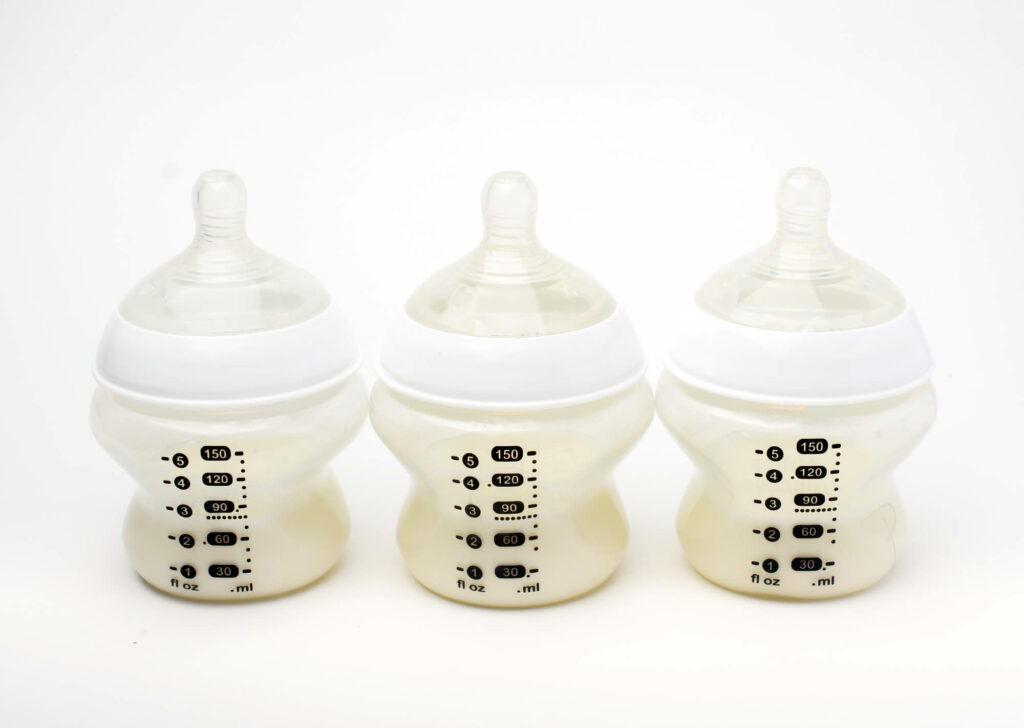Many nursing mothers collect and freeze their breast milk. Knowing how to safely defrost, reheat, and utilize frozen breast milk when the time comes is crucial. It may be essential if you need to travel or ship it, but it is more likely that you will want to build a stockpile when you must be away from your child or decide to stop nursing.
How to Thaw Frozen Breast Milk
Before feeding a newborn with frozen breast milk must first be thawed into a liquid form. There are a few methods for thawing breast milk.
1. In a Refrigerator
Milk takes the longest to thaw in the refrigerator, often approximately 12 hours to defrost. If you require breast milk the following day, you may shift your supply from the freezer to the refrigerator every night.
Remember to store milk at the back of the refrigerator, not near the door. Due to frequent openings, the front of the refrigerator may experience temperature changes. The rear of the refrigerator door will have a more steady temperature and is best suited for rapidly defrosting breast milk.
After the breast milk defrosts, you may reheat it before feeding your infant. Ensure that all the milk has thawed by giving it a good stir; if not, put it back in the refrigerator and let it settle for a while. After emptying the bottle, you should always ensure that no ice pieces are floating in the milk.
When it comes time for feeding, remove the amount required for a single feeding and keep the remaining thawed milk in the refrigerator. After defrosting, milk is stored in the refrigerator for 24 hours. Please note that you may use them within 24 hours after completely thawing, not after placing them in the refrigerator.
2. Running Water
If you are in a rush or forgot to move the frozen breast milk to the refrigerator, you may rapidly defrost it by running it under cold or warm water. Typically, you run the breast milk bottle under warm or hot water to defrost and get the milk to room temperature. You may then give it to your infant without warming it up beforehand.
If you anticipate using the full bottle or bag, run it under cold water. Once the bag has thawed, you may remove the amount needed for the next feeding and return the remaining milk to the refrigerator. (and utilize it within twenty-four hours)
3. In a Bowl of Water
Another simple method for thawing frozen breast milk is placing the bags/bottles in a hot or cold water bowl. If you employ hot water to defrost frozen milk, you may change it as it cools with new hot water.
Breast milk that has been defrosted may stay at room temperature for about two hours. There is a bigger risk of breast milk becoming bad if you store it for longer than that, so you should discard any extra before feeding your child.
How Not To Thaw Breast Milk
You may choose those three methods to defrost breast milk. Also, thawing breast milk in the microwave is NOT advisable. Another not recommended method is thawing frozen breast milk outdoors at room temperature.
How To Warm Up Breast Milk
Once breast milk has been effectively defrosted, the next step is to warm it up for the infant. There are advantages to giving your infant warmed milk. First, drinking warm breast milk is more calming and reassuring. Second, boiling breast milk will assist in dissolving the lipids that attach to the bottle’s surfaces.
If you have seen frozen breast milk, you may have observed that the fattier layer rises to the top while the foremilk drops to the bottom. You can combine it by swirling the bottle, but the fat is still on the bottle’s sides. Warming the milk causes the fats on the edges to melt, resulting in fattier milk for your infant.
There are three methods for warming breast milk.
1. Running Water
The breast milk may be run immediately under a faucet while firmly sealed. Ensure the water is warm and shake the bottle before giving it to your child. This technique is effective, but it wastes a lot of water.
2. Bowl of Water
Get a basin of warm water; you may warm it on the burner or get it from the tap. Place a tightly sealed breast milk bottle or container into the water. Wait a few minutes till the milk gets to body temperature. If the water cools too much, add warm water until the milk is adequately heated. Stir the milk so that the separated fat is included.
3. Bottle Warmer
It is perhaps the simplest method for warming a bottle of breast milk, particularly for late-night feedings when time is of the essence. You may purchase a warmer at retailers such as Amazon, but be careful to adhere to the instructions to prevent overheating strictly.
Takeaway
Whether it’s a few bags in an emergency or a large supply of bottles for when you return to work, it’s comforting to know that your kid will still have access to your breast milk even when unavailable. How frozen breast milk is thawed and used is just as crucial as how it is collected and stored. Follow the instructions in this article to ensure the safety and health of your infant and breast milk.














